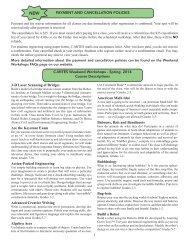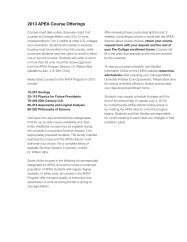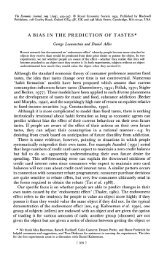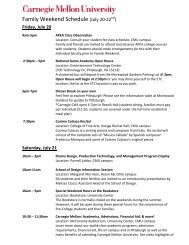Pittsburgh International Airport Area Development Vision Plan ...
Pittsburgh International Airport Area Development Vision Plan ...
Pittsburgh International Airport Area Development Vision Plan ...
Create successful ePaper yourself
Turn your PDF publications into a flip-book with our unique Google optimized e-Paper software.
7. Stakeholder Meetings<br />
Between February and May 2011, the RCI team interviewed stakeholders from local government, the business<br />
community, real estate and development interests, non-profit organizations, and airport operations. The team<br />
also met twice with the Tri-County <strong>Airport</strong> Partnership (TCAP) and took part in reviewing the Allegheny County<br />
<strong>Airport</strong> Authority’s most recent master plan.<br />
Perspectives, Townships<br />
Townships in the airport area are all interested in participating in airport-related development, but they have<br />
different interests: Moon and Robinson are looking for new commercial (including industrial, business, office,<br />
research, and retail) development to bring new jobs; North Fayette, which has seen considerable commercial<br />
development in recent years, wants to attract a larger resident population; Findlay, the least developed to date,<br />
is looking for growth in both commercial and residential development. Moon Township, which is updating<br />
its comprehensive plan, is looking to create a distinctive town center and also hopes to see development of a<br />
research/development park near the airport. Robert Morris University is an important community asset and<br />
partner. Robinson Township considers itself nearly “built out”, though a few industrial sites remain. The large<br />
commercial sites that have been developed along the airport corridor offer additional opportunities for infill<br />
development, particularly on the acreage currently used for parking if alternatives can be provided. All of the<br />
townships have difficulty acquiring funding for infrastructure, and development plans have been impeded by<br />
shortfalls in state and federal budgets.<br />
North Fayette Township<br />
<strong>Area</strong>: 16,000 acres<br />
Population: 13,000<br />
› Have attracted a considerable amount of commercial development<br />
› Priority going forward is more residential around Pointe and other existing business uses<br />
› Sees itself as a “bedroom community” and expects to grow to 21,000 by 2030<br />
› New commercial only in areas already designated and prepared for development<br />
Moon Township<br />
<strong>Area</strong>: 15,000 acres<br />
Population:22,500<br />
› Includes northern part of airport and old airport access<br />
› High residential growth of last twenty years is slowing; most land is developed<br />
› Seeking a balance of uses<br />
› Priority is light industrial, research and development, office uses<br />
› <strong>Plan</strong>ning goals: town center, better front doors, and improved University Boulevard<br />
Robinson Township<br />
<strong>Area</strong>: 12,000 acres<br />
Population: 14,500<br />
› Township has stable low-density suburban population; most land is developed<br />
› Priority is commercial or industrial development that will create new jobs<br />
› Want to hold current population steady<br />
› See opportunity for infill development on existing commercial sites, to minimize new infrastructure<br />
Findlay Township<br />
<strong>Area</strong>: 32,000 acres<br />
Population: 5,000<br />
› <strong>Airport</strong> occupies one-quarter of township area<br />
› See population increasing to 15,000<br />
› Priority is attracting new businesses and jobs<br />
› Capacity for 20 million square feet of new commercial/industrial space<br />
› Recently focusing more on protecting environmental quality<br />
Perspectives, Counties<br />
Beaver County<br />
Beaver County has seen airport-related residential development, primarily in Hopewell Township. They are<br />
looking for new industrial/office development in their business parks, such as Hopewell Business Park and the<br />
Aliquippa LTV Site. Beaver County has a number of development sites, including Aliquippa, along the Ohio<br />
River, but they are less likely to see airport-related development because they are distant or disconnected from<br />
the airport. Beaver County’s plans call for denser development in its riverfront communities and at highway<br />
intersections. The townships near the airport are primarily agricultural and are not looking to become more<br />
urbanized. County representatives indicated an interest in participating with Allegheny and Washington Counties<br />
in pursuing a regional approach to airport-related development, especially on the I-376 corridor.<br />
Washington County<br />
The high-priority development sites for Washington County are the SouthPointe and StarPointe business parks.<br />
They feel they have been successful in attracting development there and are concerned that the improvement<br />
of sites near the airport will limit the demand for their sites. Most of the northwestern area of the county--the<br />
area within a thirty-minute drive of the airport--is agricultural or recreational. The county planning documents<br />
call for policies that will improve the quality of existing communities and reduce sprawl. They emphasize consolidated<br />
development and management of natural resources to assure continued quality of life in the county.<br />
Allegheny County<br />
Allegheny County has taken an increasingly active role in promoting and facilitating airport-area development.<br />
The recently completed comprehensive county plan, “Allegheny Places”, envisions the airport area as the largest<br />
development opportunity in the county. The County’s Economic <strong>Development</strong> department and the <strong>Airport</strong><br />
Authority have engaged in public-private partnerships that currently have approximately 2,000 acres under<br />
development, including Clinton Commerce Park and Imperial Park. The extension of the Cherrington Parkway<br />
is a strategy for opening additional acreage for development. Allegheny County’s plan puts a high priority on<br />
infill and redevelopment in existing urban areas, on developing a better system of public transit, and on preservation<br />
of natural land.<br />
24 <strong>Pittsburgh</strong> <strong>International</strong> <strong>Airport</strong> <strong>Area</strong> <strong>Development</strong> <strong>Vision</strong> <strong>Plan</strong> (Aerotropolis) September 2011 September 2011 <strong>Pittsburgh</strong> <strong>International</strong> <strong>Airport</strong> <strong>Area</strong> <strong>Development</strong> <strong>Vision</strong> <strong>Plan</strong> (Aerotropolis) 25







![Pittsburgh Neighborhoods [.pdf] - Carnegie Mellon University](https://img.yumpu.com/22011290/1/190x115/pittsburgh-neighborhoods-pdf-carnegie-mellon-university.jpg?quality=85)
![Curriculum Vitae [.pdf] - Carnegie Mellon University](https://img.yumpu.com/20737100/1/190x245/curriculum-vitae-pdf-carnegie-mellon-university.jpg?quality=85)







![May 2012 [.pdf] - Carnegie Mellon University](https://img.yumpu.com/12198417/1/190x253/may-2012-pdf-carnegie-mellon-university.jpg?quality=85)
